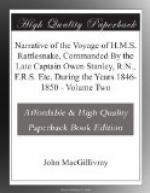On landing at Kororareka, one finds that what from a distance appear neat and comfortable cottages lose much by close inspection. The township consists of about thirty small wooden houses, mixed up with many native hovels. It extends along the shore of a small bay, with a shingly beach in front and a swamp behind. The number of houses was formerly much greater, most of those now existing having been built since May 1845, when the greater part of the town was burnt down by the natives. Even now it supports two public houses, and several general stores, where necessaries may be procured at double the Sydney prices. At one time much trade was done here, before the duties imposed on the occasion of New Zealand becoming a British colony drove away the whalers which used to resort in great numbers to the Bay of Islands to refit; at present, besides the Rattlesnake, the only vessel here is a brig from Hobart, bound to California, which put in to this place to get a new rudder. Livestock is plentiful and the prices are moderate.
There are many natives living in the settlement. They afford a striking contrast to the wretched specimens of Australian aborigines one occasionally sees in the streets of Sydney. Many of the men are athletic and well made, and in their gait and expression exhibit much manliness of character. The faces of some of the principal people present good specimens of elaborate tattooing. The women appear strange figures from their ungainly modern dress, consisting merely of a loose smock of calico, fastened at the neck and wrists. Some were tolerably handsome (according to our notions of female beauty) and among them were several halfcastes. Their fashion of dressing the hair is curious—in front it is cut short in a line across the forehead, but is allowed to grow long behind. We met Waka Nene, a Maori chief, possessing considerable influence, especially in the neighbouring district of Hokianga, who, by siding with the English during the war, rendered such important services that the Government rewarded him with a pension of 100 pounds per annum, and a house in Kororareka. Besides this he owns a small vessel or two employed in the coasting trade. I peeped into the hut of one of his people. A small entrance served the combined purposes of door, window, and chimney, the roof was so low as to preclude one from standing upright inside, a small fire was burning in the centre of the earthen floor, and a heap of mats and blankets in one corner pointed out a sleeping-place.
Behind Kororareka one of a series of hills overlooking the town is memorable as the site of the flagstaff, the cutting down of which by Heke was one of the first incidents of the Maori war. On March 11th, 1845, an attack was made upon the place before daylight, by three of the disaffected chiefs. Kawiti with one division entered the town from the southward by a pass between two hills, and after a short conflict forced a party of marines and seaman from H.M.S.




